<iframe style="width:120px;height:240px;" marginwidth="0" marginheight="0" scrolling="no" frameborder="0" src="//ws-na.amazon-adsystem.com/widgets/q?ServiceVersion=20070822&OneJS=1&Operation=GetAdHtml&MarketPlace=US&source=ss&ref=as_ss_li_til&ad_type=product_link&tracking_id=peaceinvesting-20&language=en_US&marketplace=amazon®ion=US&placement=0060555661&asins=0060555661&linkId=80f8e3b229e4b6fdde8abb238ddd5f6e&show_border=true&link_opens_in_new_window=true"></iframe>|<iframe style="width:120px;height:240px;" marginwidth="0" marginheight="0" scrolling="no" frameborder="0" src="//ws-na.amazon-adsystem.com/widgets/q?ServiceVersion=20070822&OneJS=1&Operation=GetAdHtml&MarketPlace=US&source=ss&ref=as_ss_li_til&ad_type=product_link&tracking_id=peaceinvesting-20&language=en_US&marketplace=amazon®ion=US&placement=1119404509&asins=1119404509&linkId=0beba130446bb217ea2d9cfdcf3b846b&show_border=true&link_opens_in_new_window=true"></iframe>|<iframe style="width:120px;height:240px;" marginwidth="0" marginheight="0" scrolling="no" frameborder="0" src="//ws-na.amazon-adsystem.com/widgets/q?ServiceVersion=20070822&OneJS=1&Operation=GetAdHtml&MarketPlace=US&source=ss&ref=as_ss_li_til&ad_type=product_link&tracking_id=peaceinvesting-20&language=en_US&marketplace=amazon®ion=US&placement=1119376629&asins=1119376629&linkId=2f1e6ff64e783437104d091faaedfec7&show_border=true&link_opens_in_new_window=true"></iframe>

By Josh Katzowitz, WCI Content Director
Despite the COVID pandemic and all the uncertainty it brought, doctors managed to increase their average salaries in 2020 and 2021. In 2022, though, that abruptly changed. According to the newly released 2023 Doximity Physician Compensation Report, the average physician's salary actually dropped 2.4% in 2022.
And it might not be getting better.
According to Doximity:
“In 2023, physicians will also experience a 2% Medicare payment cut after two decades of flat payments. According to the American Medical Association, when adjusted for inflation, Medicare physician payment has declined 22% from 2001 to 2021. These challenges are driving many medical professionals to reassess their careers; explore opportunities for greater autonomy and work-life balance; and in certain cases, even consider new career pursuits outside of medicine altogether.”
The average physician salary increased an average of 3.8% from 2020 to 2021 and 1.5% from 2019 to 2020. But some of those gains were wiped away in the latest survey, which included responses from more than 31,000 US doctors. Considering inflation reached a high of 9.1% in the summer of 2022, the purchasing power for the average physician dropped drastically.
That also means a doctor's net worth also probably decreased, particularly since stocks and bonds both had terrible years in 2022.
In another Doximity article released in August 2022, a survey of more than 1,000 doctors found that 55% of them are either delaying retirement (about 40% of those who were surveyed) or reducing their expenses (about 15%) because of the current economic environment. According to Doximity, “Older physicians, who are closer to the traditional retirement age, are much more likely to delay retirement than younger physicians. But a substantial percentage of those in their 30s and 40s are also planning to delay retirement.”
According to Doximity’s data, the gender pay gap slightly narrowed to 26% in 2022 (down from 28% in 2021), as male doctors earn about $110,000 more than their female colleagues per year (it was $122,000 in 2021). That disparity also could have led to more cases of physician burnout.
“While there appears to be slight movement in the right direction, physician pay parity continues to be a critical area in need of improvement,” Doximity wrote. “This pay gap may be contributing to an even higher burnout rate among women physicians, with nearly 92% of women physicians surveyed reporting overwork, compared to 83% of men.”
Average Doctor Salary
In reality, the average doctor's salary isn't all that useful to know.
As an example: according to the Doximity report, the average pediatric infectious disease doctor makes $221,126 per year. The average neurosurgeon makes $788,213. Between those two, the average is $504,670. Which, when comparing those two specialties, means absolutely nothing. Plus, consider that, according to Medscape, the average primary care physician makes $260,000 vs. a specialist who makes $368,000. That's also a pretty big difference. Here's a quick look at general compensation from Medscape's most recent survey.
Medscape Physician Compensation Report 2023
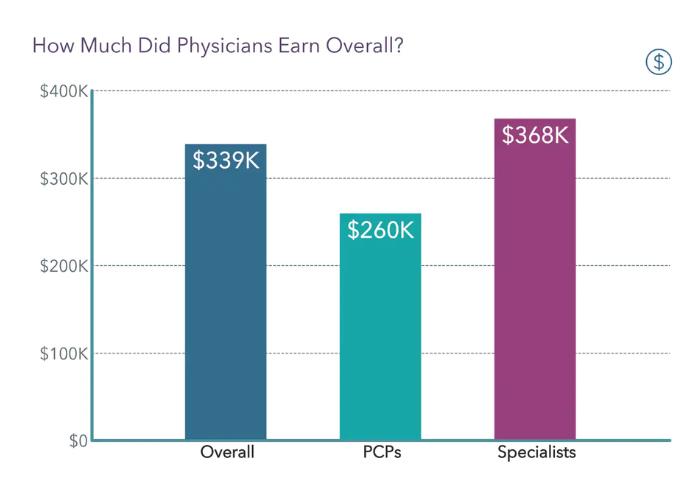
It's almost certainly more useful to know the average in a doctor's specialty as opposed to the salary of a physician in general.
Intraspecialty Pay vs. Interspecialty Pay
As Dr. Jim Dahle has repeatedly pointed out, “One of the things I have noticed, that no one ever seems to talk about, is that intraspecialty pay variation is higher than interspecialty pay variation.”
As Jim noted in a previous post, here’s a chart from 2015 that shows the results of an Emergency Medicine salary survey. The salaries might be outdated, but the general point remains.
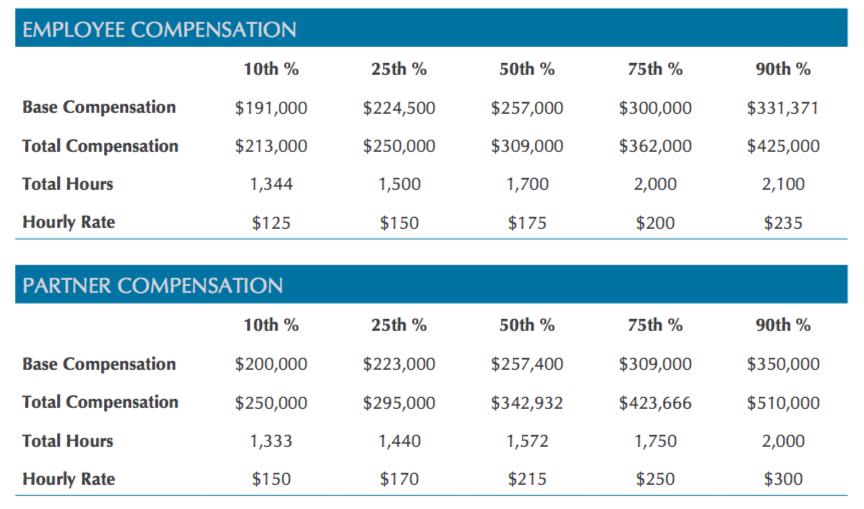
He wrote:
“Look at the 10th percentile for employees—$213,000. Now, look at the 90th percentile for partners—$510,000. Difference? $297,000. GREATER than the difference between the average pediatrician and the average plastic surgeon!
The ability to increase pay and increase it substantially solves a ton of financial problems that real doctors run into and email me about all the time. It's way easier to pay off your student loans or mortgage on twice the income. Even after-tax, it's much easier to become financially independent or have a dignified retirement or send your kids to the college of their choice when you can double your income.”
How Much Do Doctors Make an Hour?
Physician income information is relatively easy to find, but work hours information is notoriously difficult to find. The only information that combined physician work hours with their income is from a survey in JAMA published in 2003 (and obviously using even older data).
The below physician salary per hour combines the JAMA data with Medscape’s 2022 survey, and it's adjusted for the decreased work hours in each specialty. This chart (possibly erroneously) assumes that all physicians work 48 weeks a year. Where Medscape didn’t have survey data, other less reliable sources were used. Those figures have an asterisk next to them in the table.
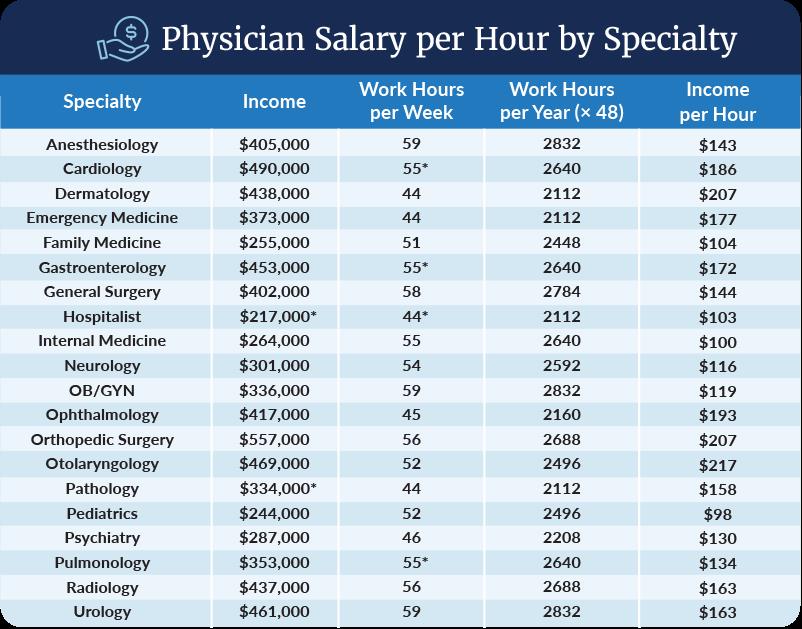
Doctor Salary by Specialty
One interesting thing about salary surveys, of course, is that they are garbage in/garbage out. Average specialty pay varies significantly between surveys. Before we focus on the Doximity numbers, which you'll find in the paragraphs below, compare and contrast those numbers with those from the Medscape survey published in 2022.
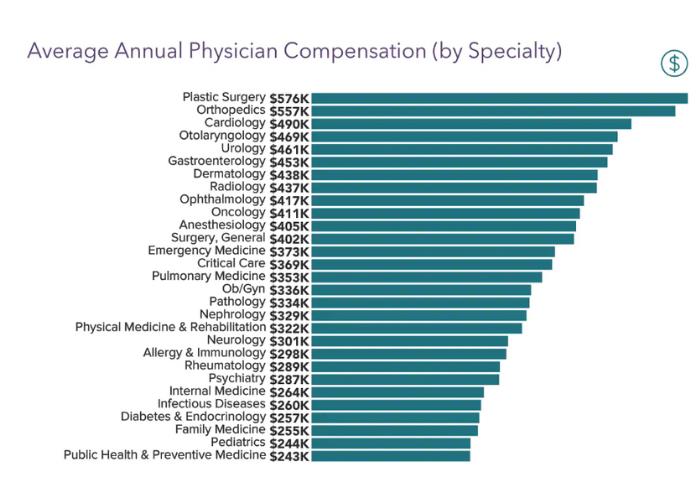
Medscape says infectious disease doctors make $260,000. Doximity says $289,000. That's nearly a 10.6% difference. Medscape says orthopedists make $557,000. Doximity says $624,000, 11.3% more. What is a new grad or even an established doc who is wanting to negotiate a contract supposed to do with that much variation between averages (besides use the Doximity survey when negotiating)? And what if you're in one of those “specialties in the middle” like OB/GYN or Psychiatry or Emergency Medicine or Neurology that Doximity didn't even report on despite how common they are? Or if you're a Neurosurgeon or CT surgeon, and Medscape doesn't report on your specialty? Are you stuck paying to get MGMA data (or hiring a contract management firm)? Is that data even any better than these surveys?
For even further exploration, here are a number of individual specialties that Medscape looked at, how much money those doctors make, and whether they think their income is fair:
- How Much Does a Pediatrician Make?
- How Much Does a Radiologist Make?
- How Much Does an Anesthesiologist Make?
- How Much Do Psychiatrists Make?
- How Much Does a Neurologist Make?
- How Much Does a Cardiologist Make?
- How Much Does a Dermatologist Make?
- How Much Does a Urologist Make?
- How Much Does a Pathologist Make?
- How Much Does a Plastic Surgeon Make?
- How Much Does an Oncologist Make?
Highest-Paid Doctors
Now, for the Doximity survey numbers that tell us the highest-paid and the lowest-paid doctors. When it comes to the top-earning specialties, those in surgical and procedural specialties dominated the list, and doctors who earn the least mostly practice in primary care and pediatrics.
So, how much do doctors make? Here’s what Doximity found for 2023.
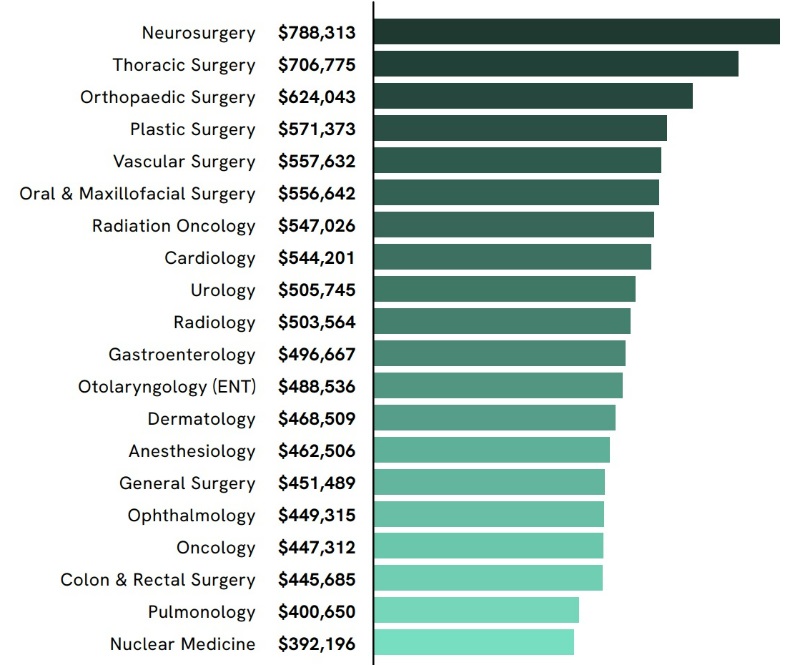
Lowest-Paid Doctors
And here are the specialties that earn the lowest salaries.
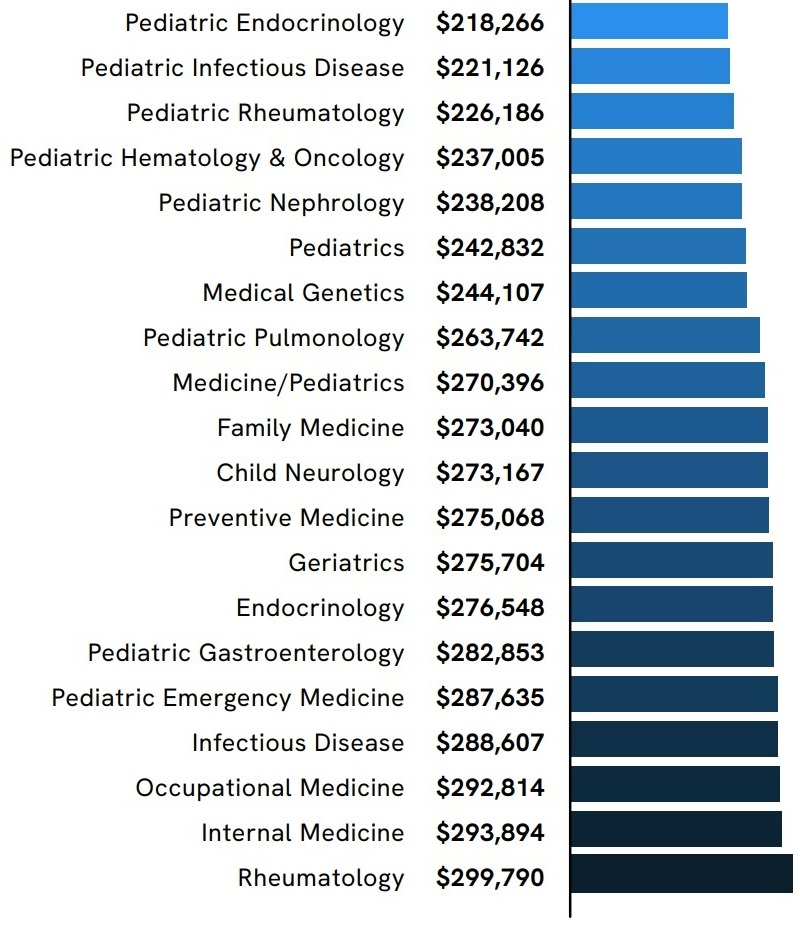
Keep in mind that these charts are of the top-20 highest and lowest average doctor salaries. For specialties like psychiatry, adult emergency medicine, and allergy and immunology, those average salaries likely range from about $311,000 to about $384,000.
As for which specialty's salaries are increasing the most, here's a chart put together by Doximity.

Despite its drop in popularity among the latest class of fourth-year medical students matching into residency, emergency medicine docs continue to make more money, as do a number of pediatric specialties.
More information here:
How Much Do Surgeons Make?
Doctor Salary by State
One way to get closer to financial independence is to practice geographic arbitrage, where a doctor lives in a lower-cost-of-living area and draws a higher salary where the need for physicians might be greater than those in the big cities on the coasts. The following chart from Medscape seems to show that geoarbitrage is not a myth.
Doctors, at least going back to the 2020 survey (this chart was unavailable in the latest survey), make the highest salaries in states like Alabama, Kentucky, Oklahoma, Indiana, and Missouri. All are so-called flyover states, and none are in the top-15 among the states with the biggest populations.
Doximity 2020 Physician Compensation Report
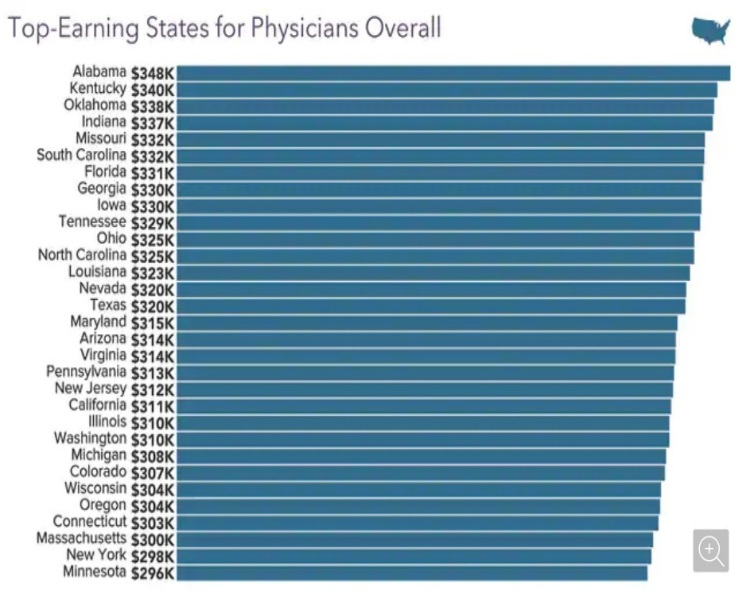
Medscape 2023 Compensation Report
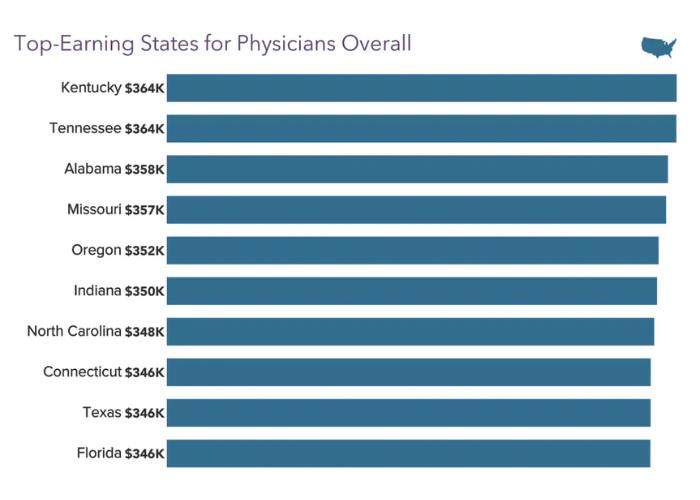
Obviously, a doctor living in New York City is going to have a much higher cost of living than a physician who's residing in Florence, Alabama. The fact that a doctor in the Yellowhammer State probably brings home more money than that physician in the Big Apple is also another point in favor of practicing geographic arbitrage.
Doctor Salaries by Employment Setting
The setting in which a doctor practices also heavily affects how much they earn. As you can see below, the difference between practicing in a single-specialty group vs. working for an urgent care center can be nearly $175,000 a year in 2022.

-
- Single Specialty Group: $438,959 (a 0.7% decrease from 2021)
- Multi-specialty Group: $421,159 (a 0.7% decrease from 2021)
- Solo Practice: $428,112 (a 3% increase from 2021)
- Hospital: $398,954 (a 0.1% decrease from 2021)
- Industry/Pharmaceutical: $392,534 (a 0.8% decrease from 2021)
- Health System/IDN/ACO: $400,207 (a 1.4% increase from 2021)
- Health Maintenance Organization: $387,393 (a 3.4% increase from 2021)
- Academic: $347,013 (a 0.9% decrease from 2021)
- Urgent Care Center/Chain: $264,727 (a 1.0% decrease from 2021)
- Government: $269,189 (a 1.8% increase from 2021)
Need tips for how to increase pay in your specific specialty? Jim has some ideas.
There's plenty more to read in the entire Doximity report—which also includes information on physician compensation in different metro areas, cities with the fastest-growing doctor salaries, and the impact of economic factors on career plans. For comparison, here's Medscape's Physician Compensation 2022 Report.
What do you think? Are you surprised by any of these numbers? Have you found a way to increase your pay inside your specialty? Comment below!
[This updated post was originally published in 2022.]
The post How Much Money Do Doctors Make a Year? The Average Salary Is Dropping appeared first on The White Coat Investor - Investing & Personal Finance for Doctors.
||
----------------------------
By: Josh Katzowitz
Title: How Much Money Do Doctors Make a Year? The Average Salary Is Dropping
Sourced From: www.whitecoatinvestor.com/how-much-do-doctors-make/
Published Date: Wed, 26 Apr 2023 06:30:08 +0000
Read More
.png) InvestingStocksToolsClubsVideosPrivacy PolicyTerms And Conditions
InvestingStocksToolsClubsVideosPrivacy PolicyTerms And Conditions
